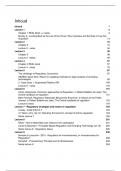Inhoud
Inhoud 1
Lecture 1 3
Chapter 1 REAL Book (+ notes) 3
Murray A, ‘Looking Back at the Law of the Horse: Why Cyberlaw and the Rule of Law Are
Important’ 14
Lecture 2 16
Chapter 2 16
Lecture 2 - notes 34
Lecture 3 38
Chapter 3 38
Lecture 3 - Notes 48
Lecture 4 57
Chapter 4 REAL book 57
Lecture 4 - notes 79
Lecture 5 87
The challange of Regulatory Connection 87
SIENNA report D6.2: Report on adapting methods for legal analysis of emerging
technologies 90
2. Case study 1: Augmented Reality (AR) 106
Lecture 5 - notes 118
Lecture 6 131
Cento Veljanovksi, Economic approaches to Regulation, in Robert Baldwin etc (eds), The
Oxford handbook of regulation 131
Mike Feintuck, Regulatory Rationales Beyond the Economic: In Search of the Public
Interest, in Robert Baldwin etc (eds), The Oxford handbook of regulation 142
Lecture 6 notes 154
Lecture 7 - Regulatory strategies and means of regulation 164
Lessig - Code [V2] Ch.7 164
4.7 Abort, retry, fail. Or: liberating the boxed-in concept of techno-regulation 184
Notes Lecture 7 185
Lecture 8 201
Reed - How to Make Bad Law: lessons from cyberspace 201
Carter & Marchant - Principles-Based Regulation and Emerging Technology (ch.10) 220
Notes lecture 8 - Regulatory failure 226
Lecture 9 238
Butenko & Larouche - 2015 - Regulation for Innovativeness, or Innovativeness for
Regulation? 238
Hemphill – Precautionary Principle and its Weaknesses 248
Notes lecture 9 254
,Lecture 10 276
Lavrijssen & Vitez - Make Hydrogen While the Sun Shines 276
[ notes on lecture 10 are in document of lecture 9 as it was about hydrogen] 287
Lecture 11 288
Special Issue Experimental Legislation in Times of Crisis, Sofia Ranchordás & Bart van
Klink (eds.)* 288
Notes lecture 11 299
,Lecture 1
Chapter 1 REAL Book (+ notes)
WHAT IS REGULATION
1.1. Introductie
Notes lecture:
- LTS model: law, technology and society. Technology → issue → intervention.
- Technology does not develop in a vacuum, the regulation around the world is taken into
account as well as fundamental values.
- The issue can be a risk or problem, and there can be a gap in existing regulation;
lacunae, unintended effects or lack of enforcement. = regulatory gap/ disconnect. If this
is the case, then intervention is necessary!
- Flawed law syndrome = when we call for action too fast when we see an issue.
1.2 Sociotechnical change
Technologies must be understood as integrated cultural, economic, institutional, and built
phenomena. Looking at a technology as just an artifact (man made object), like the locomotive
or the smartphone that you can pick up, would for many technologies lead to gross
oversimplification and dysfunctional analysis.
We need to look at the sociotechnical context that incorporates the technology to understand
what the technology means, what (potential) issues it raises and how we can potentially deal
with these issues from a policy perspective. It is the sociotechnical change in which technology
features that matters, not the technology itself.
, new technology → issue (what is the problem with this technology, is the framework OK) →
intervention (like applying the GDPR)
Example: who is liable when a self-driving car creates an accident?
→ ethical theories will specify why exactly this is a problem.
1.3 A road trip to Technology peninsula
Technology is in need to be constantly updated.
Most of the times it concerns technologies at the forefront of technology, hence Chat-
bots are in, Autobahn is out. While it keeps the field of law and technology dynamic, as is the
underlying technological development, it requires a constant update of what is currently Wired
instead of Tired, as one of the popular tech journals (Wired) calls it.
An interesting side-effect of this Wired/Tired distinction is that some phenomena relating to
innovation and technology are within the realm of law & tech scholars, while similar, or even
bigger developments or advances are not interesting to them and ‘left’ to the traditional legal
disciplines.
1.3.1 Defining technology
The Stanford Encyclopedia of Philosophy (SEP ) has a lemma on philosophy of technology and
after 88 occurrences of the word technology it comes up with the following “Technology can be
said to have two aspects or dimensions, which can be referred to as instrumentality and
productivity.
SEP Technology = instrumentally + productivity
Instrumentality covers the totality of human endeavors to control their lives and their
environments by interfering with the world in an instrumental way, by using things in a
purposeful and clever way.
Productivity covers the totality of human endeavors to bring into existence new things through
which certain things can be realized in a controlled and clever way.
Henryk Skolimowski's argument that science deals with what exists, while technology focuses
on what can be created. This view is supported by Herbert Simon. Additionally, Mario Bunge
argues that technology is applied science but highlights the subtle differences between the two.
Technology involves action rooted in theory, differentiating it from the arts and crafts and placing
it on par with science.




